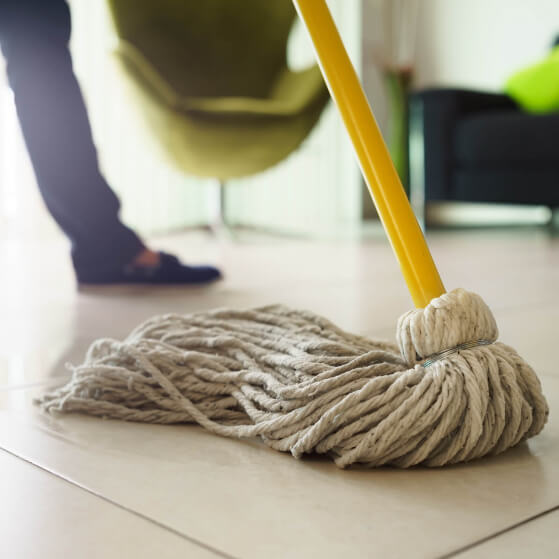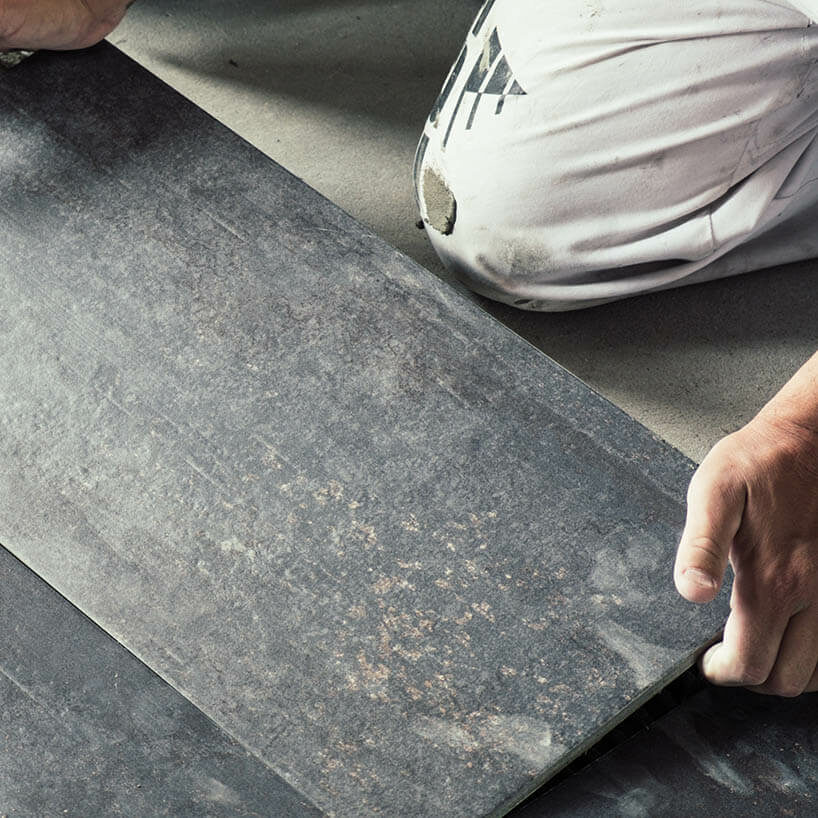Tile FLOORING
Tile is versatile, stylish, and incredibly sturdy.
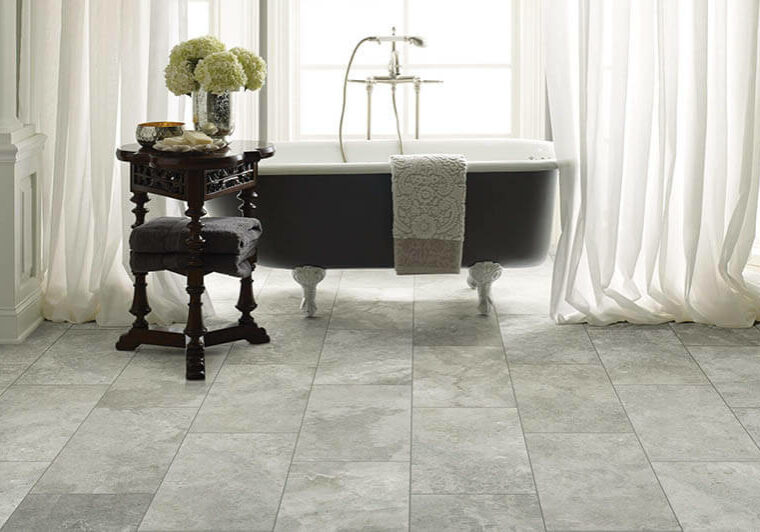
Quality Tile For New Homes
Create beautiful rooms with the versatility and timeless style of tile flooring. Tile enhances the overall look and feel of a home, and since it is waterproof, it can be used in rooms prone to moisture, such as kitchens, bathrooms, and laundry rooms. Available in a wide selection of colors, patterns, designs, shapes, sizes, and materials, tile allows you to truly customize the look of any home. Tile is also perfect for walls, including backsplashes, shower walls, and even accent walls.
At The L&L Company, we carry quality tile from the top manufacturers to provide you with the latest designs and best products currently available. Our tile will remain pristine for many years, leaving homeowners pleased.
We are the preferred tile flooring provider for builders in the Mid-Atlantic, and we look forward to working with you to create a beautiful space.
Why Choose Tile Flooring?
Tile is strong and incredibly durable, making it a great choice for any room of the home. Tile will add sophistication and elegance for many years because of its ability to resist stains, fading, scratches, and wear and tear. With the right care, tile floors can last a lifetime.
You will love the visual appeal of tile flooring in your home.
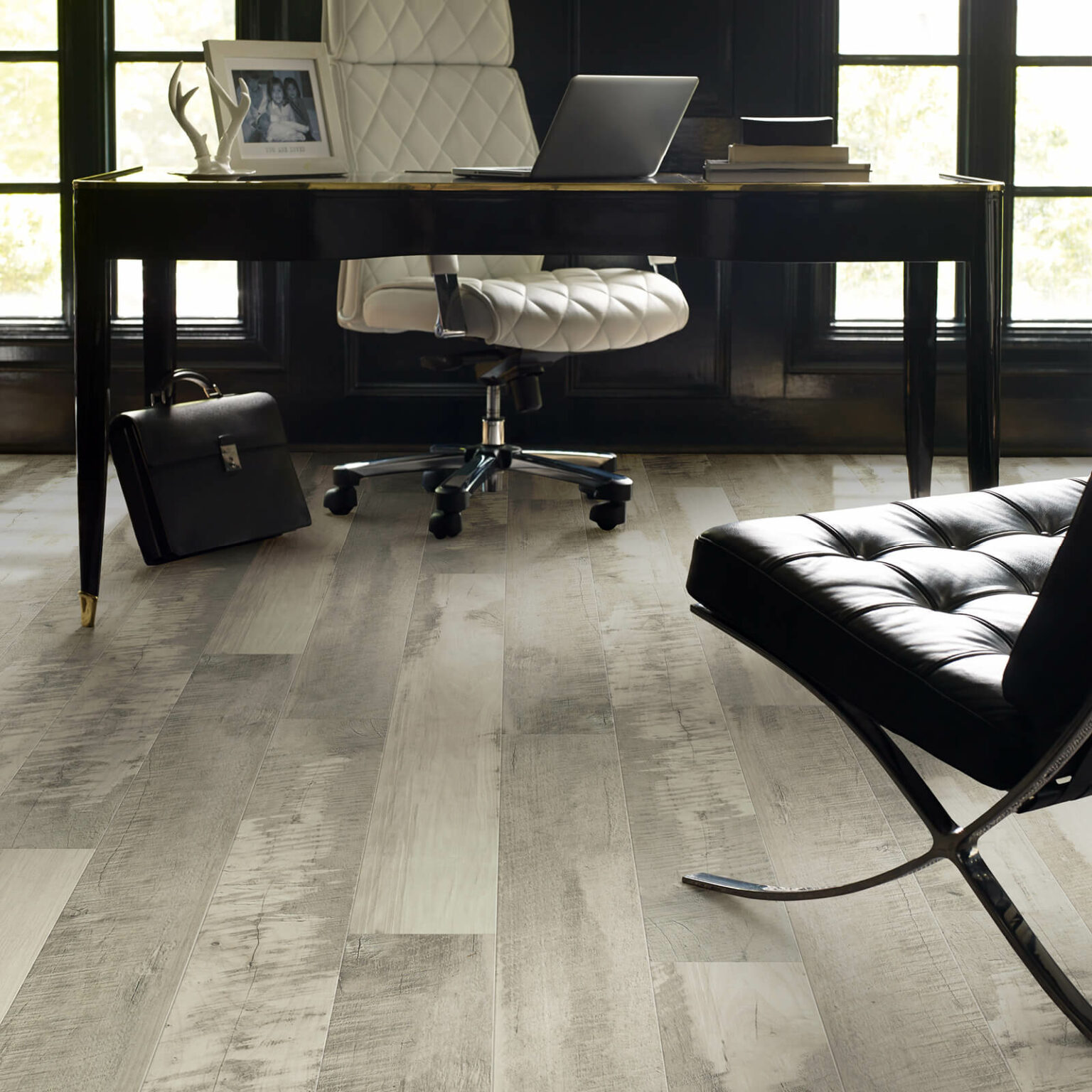
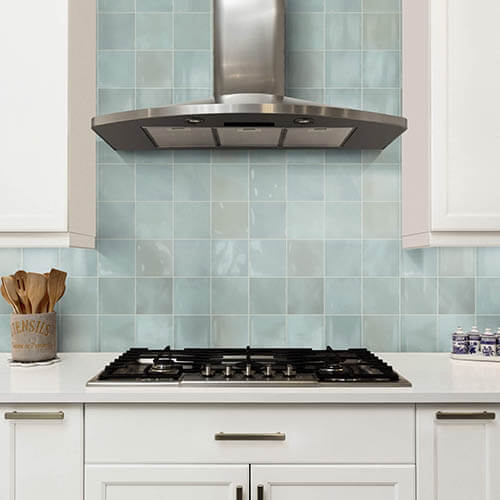
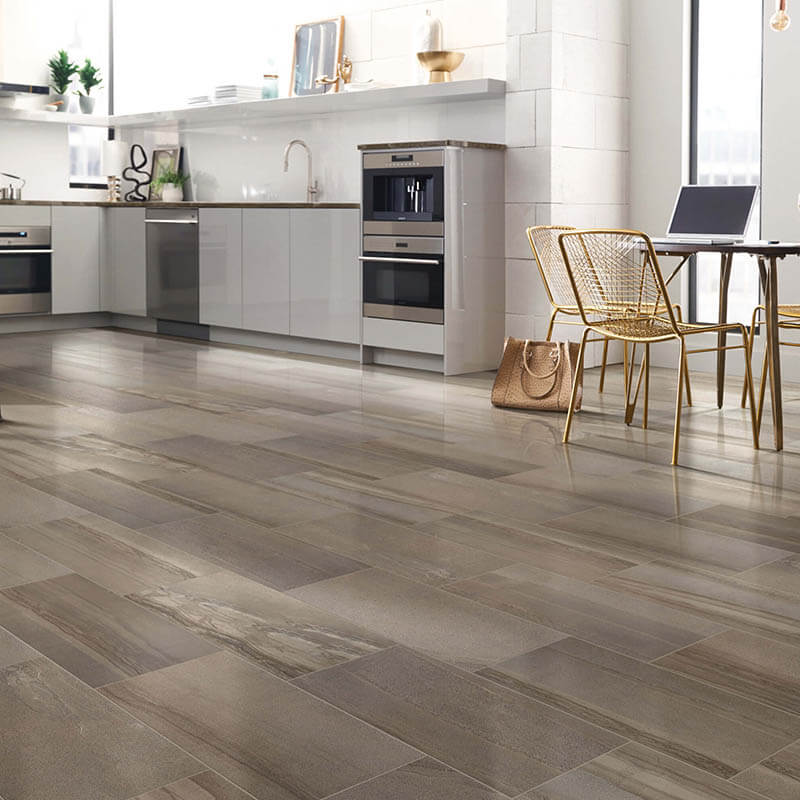
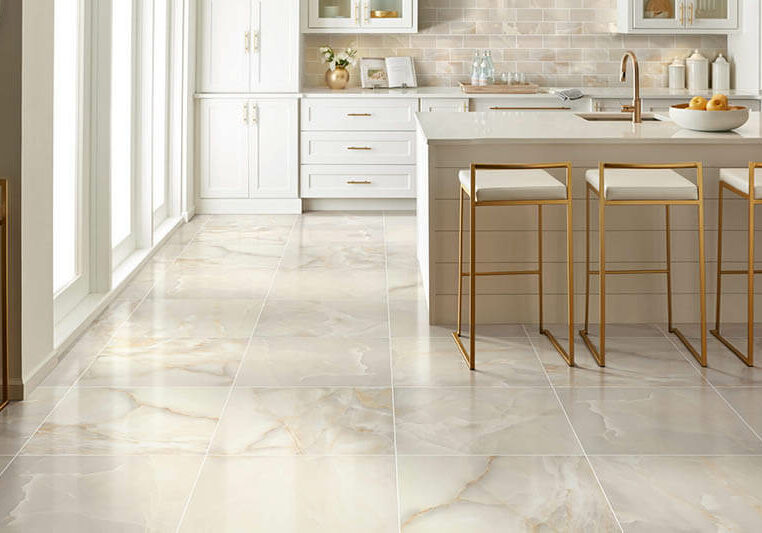
Need Inspiration?
Look at the latest trends and ideas for using tile flooring in our inspiration gallery.
Learn More About Tile
Before you Buy
Buying ceramic tile can be challenging, unless you know this.
The good news is that ceramic flooring offers you a multitude of styles, textures, patterns and price points. However, all that variety, and decisions, can be real challenging for the unknowing shopper.
In this section we’ll introduce you to information on topics such as ceramic tile trim, color and shading, moisture absorption and grout. All in our effort to make you a smarter shopper long before you open your checkbook or get out the charge card.
That way your final decision not only creates a warm, beautiful living environment but also delivers what ceramic floors are noted for: excellent durability and easy maintenance.
So we invite you to read on. Come learn the ins and outs, the tips and hints, the delights and discoveries of this unique product called ceramic tile.
For those who love to customize, ceramic rules.
The beauty of ceramic tile is the flexibility you have with design options, especially through the use of the accent pieces: trim work and decorative tiles.
However, if you’re interested in applying trim work and decorative tiles you should know that there is a definite step-by-step procedure.
The correct order of this process is to first identify the room and its application, select the type of tile, then its color and shade, and then its texture and size.
Finally, a layout pattern is designed, the trim and decorative patterns are determined, and the grout color and type are chosen.
Adhering to this process will ensure a smooth installation without any missing elements.
To help you insure a smooth understanding of floor tile trim terminology, allow us to cover a few definitions.
Floor Tile Trims
Bullnose. It has one rounded finished edge on the tile to give a nice finishing touch. Sometimes it is also used as a substitute for cove base.
Corner Bullnose. It has two rounded finished edges on the tile to be used to complete a corner.
Sanitary Cove Base. It has a rounded finished top like a bullnose to cover up the body of the tile.
Important tips on variation, texture, shading and color.
Many of today’s popular styles of ceramic tile are designed to look and feel like natural stone, emulating their rugged surface and color variations.
It’s important that you understand these variations when designing with ceramic tile.
These tiles are intended to show color and texture variations, just like natural stone. Since the composition of the tile’s glaze also varies, different tile styles will also exhibit different gloss levels.
You should also be aware that solid color tiles provide a consistent look, however shade variation is inherent in all fired ceramic products and certain tiles will show greater variation within their dye lots.
Shade variation is usually listed on the back label of each sample with a low, moderate, high or random rating. Here, to help you, are the definitions:
Low. Consistent shade and texture
Moderate. Moderate shade and texture variation
High. High shade and texture variation
Random. Very high shade and texture variation
The color of the body of the tile is determined by the color of the clay used by the manufacturer that is available in their geographic region.
Look at the body of the tile to see if the color is red or white. The quality of the tile is more related to the quality of the manufacturer, not the color of the body.
Color variations will also be present between manufacturers’ samples of the same color and throughout installed countertops, wall tile or ceramic floors.
Color consistency is something you should understand and carefully consider when selecting ceramic tile. Our sales associate will be happy to review with you what to expect from different ceramic tiles.
What smart shoppers should know about moisture absorption and tile density.
As the composition of glaze varies, different styles of tile will exhibit different gloss levels and surface textures. This is important to note when choosing your ceramic tile flooring.
For example, in areas that are used while wet, such as your shower or bathroom floor, they should have low moisture absorption and good slip resistance.
Moisture Absorption means that, as the density of the tile increases, the amount of moisture that tile can absorb becomes less.
Tile Density means that, as the weight or the density of the tile increases, it becomes a stronger tile.
Tile density and moisture absorption have an indirect relationship to each other. What this means is that as the density of the tile increases the moisture absorption rate becomes less.
Tile density and moisture absorption is important for you to understand when selecting tile for different applications. Here is some information to help in your decision making process.
Non-Vitreous Tiles are tiles that absorb 7% or more moisture. They are suited for indoor use only.
Semi-Vitreous Tiles are tiles that absorb from 3% to 7% moisture. They are applicable for indoor use only.
Vitreous Tiles are tiles that absorb less that 3% moisture. They are referred to as frost resistant tiles but cannot be used in exterior areas where freeze- thaw conditions could cause tile cracking.
Impervious Tiles are tiles that have less than .5% moisture absorption. These tiles are frost proof and can be used in exterior areas or on the outside of building facades.
The ins and outs of grout.
Grout is typically mixed on site, but slight color variations can occur within different areas of the same installation with the same grout color, and can vary from the manufacturer’s sample you saw in the store.
This can be attributed to variations in temperature and humidity at the time of grouting and it’s just a fact of life.
It is also common to see grout variations when comparing the grout color in a tile floor and the same grout color on the tile countertop or wall.
When choosing a grout color you can select a color that blends in with the overall color of the tile to minimize the appearance of the grout.
Or you can select a grout color that is lighter or darker than the tile.
If the tile is installed in a high traffic area then you may want to select a darker grout.
Exact layouts, type of grout and grout joints widths are determined by the tile setter at the time of installation and are governed by the actual size and shape of the tile, and the exact dimensions of the areas to be covered.
Once the tile has been laid and grouted, it is your responsibility to maintain all caulked areas to guard against water damage. Grout may also darken over time in areas with heavy water use.
Also, changes of season can cause surfaces adjoining the tile to expand and contract, causing the grout to crack and separate.
A word or two about subfloors.
No subfloors are perfectly level. So, you may hear hollow sounds where your subfloor’s surface dips and ridges.
Be assured that this does not affect the integrity or installation of the ceramic tile. Hollow sounds are normal and are not considered a product or installation defect.
Get on top of the bottom line. Know the entire cost of ownership.
The “cost per square foot” of your ceramic floor is just one component of the entire project cost. To ensure there are no surprises, and the ceramic you select fits within your overall project budget, be sure to ask us to calculate the total cost of your floor covering project.
Here’s a list of potential additional expenses you may incur:
- Furniture removal/replacement.
- Demolition/disposal of old floor covering. Depending on the existing floor covering, this can be an expensive item; also, be sure to include the cost to dispose of the old floor covering.
- Subfloor preparation. Depending on the condition of the subfloor, it may require additional work.
- Product delivery.
- Installation. Determine the cost per square foot to install it.
- Materials required to complete the installation. Your new floor may require additional materials to install it properly.
Also, don’t forget to ask the retailer and consult the manufacturer’s warranty and care guide for directions on how frequently your floor should be cleaned and the cost to clean it.
There’s a lot to know and consider before buying your ceramic tile floor, but it’s well worth the effort.
If you’re a smart and knowledgeable ceramic tile shopper it will put us in fine spirits. And, hopefully, put your home into showcase status.
How it's Made
Up to date knowledge on how this ancient product is created.
Regardless of which floor covering product you eventually decide on, it will be constructed or manufactured in some manner. But how ceramic is created is in a world all its own.
The process is ancient and the resulting benefits are many and desirable: beauty, durability, practicality and versatility.
Ceramic tile is a work of art you walk on -- a spectacular entryway, a refreshing bath/spa surface, a gourmet kitchen’s feast for the eyes. Ceramic tile is art underfoot that you admire as owner and covet as visitor.
Understanding how ceramic is made provides you with knowledge of it right from its birth. That’s important information because these are the materials you’ll be living with for years to come should you choose this flooring product.
Knowing ceramic construction also helps you better understand and evaluate its performance aspects. You’ll discover why some ceramic products are easier to clean than others; why some are more durable.
Plus, understanding how ceramic is made can make you a better shopper, help you determine ceramic flooring value and keep you “in the black” regarding your home improvement budget.
So please read on and we’ll help you learn how ceramic is made, cover the various steps involved, discuss alternate types of ceramic, and offer you an easy to understand abrasion rating system.
Ceramic production unites earth and fire.
The main ingredients of ceramic tile and its general manufacturing process has not changed that much throughout the centuries.
All ceramic tiles are created from natural products extracted from the earth that are shaped into tiles and then fired in kilns at extremely high temperatures.
A guide to the two classes of ceramic tile.
There are 2 main types of tile construction: glazed and unglazed.
When you look at a glazed tile from the side you can see 2 layers. The body of the tile, or largest layer, is called the bisque. The top layer is called the glaze, as in glazed donut.
Glazed tiles have a hard non-porous, impermeable surface after firing. They are more stain resistant than unglazed tile and are easy to clean. Something to consider for those more active areas of your home like the kitchen and baths.
Unglazed tiles add a whole different beauty to your home. They are solid colored all the way through and do not have a top layer of glaze. This is often referred to as through-body construction.
They have no additional surface applications and are typically more dense and durable than glazed tile. Thus they are more suitable for interior and exterior applications where wearability is a concern.
If your home has areas of heavy activity or kid “zones,” unglazed tile may be just the answer.
There are 5 steps in the ceramic tile manufacturing process: Mining, Blending and Mixing, Pressing, Glazing, and Firing.
Step 1 is basic and organic.
The process begins with the mining of the raw materials, which is a mixture composed of mostly clay and minerals.
Step 2 transforms mud into fine sand.
The clay and mineral mixture is blended and mixed into a semi fine powder.
Water is added to form a wet slurry or mud-like consistency. Then the slurry is pumped into a large dryer.
And the result? A fine clay powder that feels like warm, fine sand.
Step 3 sees a form take shape.
Next, the clay is pressed or formed into a tile shape. These pressed tiles are called green tiles at this stage.
There is also another method called extrusion which can replace the pressing step. Extruded tiles are formed by forcing the clay material through a mold for the desired shaped versus pressing the tile.
However, pressing is the more common method used today. And after the green tiles are formed they are dried to remove some of the moisture.
Step 4 is the glaze phase.
It’s the next step in the manufacturing process for those tiles that will have a glaze.
If the tile is to remain unglazed it skips this step and goes directly to the firing kiln.
The glaze liquid is prepared from a glass derivative called frit and colored dyes. The glaze is applied by either a high-pressure spray or is poured directly onto the tile.
Step 5 really heats things up.
The ceramic tiles are now fired in the kiln at temperatures around 2000 degrees Fahrenheit.
Tiles that are fired once after the glaze is applied are called monocoturra tile or single fired.
The other type is called biocuttura or double fired tile. Biocuturra tiles are first fired after the green tile is dried and then fired again after the glaze is applied.
An optional, durable choice is porcelain.
Aside from the 2 types of ceramic tile, glazed and unglazed, there is another category that continues to gain popularity – beautiful, elegant, porcelain tile.
Porcelain tile is made up of 50% feldspar and is fired at a much higher temperature than regular ceramic tile. This makes porcelain tile much harder and more dense than other tile products.
Their high performance and low water absorption ratings of less than 0.5 percent make these tiles a worthy choice for your home.
Additionally, porcelain tile can be used for interior and exterior applications as well as heavy or commercial areas.
After the finished tiles have been inspected for quality assurances, they are packaged, crated and ready to be shipped.
Understand this to be a savvy tile shopper.
Not all ceramic tile is suitable for each area of your home. The beautiful, decorative tile you might put on your kitchen backsplash may not be recommended for installation on the floor.
Most manufacturers have a rating system that is based on or supported by the American Society for Testing & Materials (ASTM). Many times you can find these ratings on the tile sample or in the product catalog.
The most common system rates ceramic tile abrasion resistance or the overall durability of the tile. There are 5 classes you should know about.
Class 1: no foot traffic.
These tiles are suggested for interior wall applications only and not for the floor.
Class 2: light traffic.
These tiles are suggested for interior wall applications and for residential bathroom flooring only.
Class 3: light to moderate traffic.
These tiles can be used for residential floor and wall applications including bathrooms, kitchens, foyers, dining rooms and family rooms. They’re a good all-around performer.
Class 4: moderate to heavy traffic.
These tiles are recommended for residential, medium commercial and light industrial floor and wall applications including shopping malls, offices, restaurant dining rooms, showrooms and hallways.
Class 5: heavy/extra heavy traffic.
These tiles can be installed anywhere. They will hold up in floor and wall applications at airports, supermarkets and subways. Tile doesn’t get any tougher.
You may also see a rating for Slip Resistance, which is measured by its Coefficient of Friction (COF). The higher the COF the more slip resistant the tile. This is important when selecting a floor tile for areas that get wet, such as your shower or bathroom floor.
Other ratings listed by the manufacturer might include: scratch resistance, moisture absorption, chemical resistance and breaking strength.
This concludes our section on how ceramic is made – its different types of construction, its manufacturing process and how tile is rated in terms of activity.
We hope that knowing how ceramic tile is made will help you with the decision on whether it’s made for your home and for your style of living.
Tile Styles
What’s important to know about tile types, sizes, styles and grout.
The world of ceramic tile is wide and spectacular, with a seemingly endless family of product choices and style options.
Ceramic tile flooring and wall products are offered in a broad range of textures, patterns and sizes.
When combined with a spectrum of grout and glaze options, they offer significant design options for any room in virtually any home style.
The goal is to know what is the best combination of aesthetics, style and performance that fits your floor covering budget.
To help you know, shop and decide, we offer this section.
Here we explain ceramic types, sizes and styles and offer you all the information you need to make smart choices.
We invite you to join us as we describe the beautiful and vast world of ceramic tile styles.
A universe so large there’s bound to be a ceramic tile perfect for your home and lifestyle.
The basic 3: transforming, timeless and tasteful.
There are 3 types of ceramic tile: glazed, unglazed and porcelain. Understand them and you’re home free.
Click on a swatch below for more information
Glazed ceramic tiles are coated with glass-forming minerals and ceramic stains.
Typically, they have a matte, semi-gloss or high-gloss finish.
They can offer better stain and moisture resistance than unglazed tile.
Glazed tiles can also have different finishes and you should be aware of them for future considerations.
High gloss finishes can be more slippery and scratches can become more visible, while matte or textured finishes help with traction and scratches, and dirt is less visible.
Unglazed ceramic tiles are very hard and dense. They come in various surface treatments and textures.
Typically, these are installed outside your home as they do not offer much protection against stains compared to glazed ceramic tile.
Unglazed tiles do have good slip resistance, however please note that they do require sealing to help prevent staining.
Porcelain tiles usually fall in the ceramic tile category and are the hardest and densest tiles available.
Because the color in porcelain tile goes all the way through, they are non-porous, resist scratching and can withstand temperature extremes.
Sizes, and selection, abound.
Ceramic tile is manufactured in sizes ranging from one inch to twenty-four inches square. So bring a tape measure when you go shopping.
Ceramic tile is normally boxed and priced by the square foot, regardless of the size of the individual tile itself.
You should also know that tile size is relative. Tile is usually referred to by its nominal size, not its actual size.
During the firing process, ceramic tile will shrink, on average, by about 10% in size. For example a 12” by 12” floor tile will actually measure 11-7/8 inches square.
Currently, the most popular ceramic floor tile are the larger sized tiles such as 13” by 13”, 16” by 16” and 18” by 18” sizes.
Tile size takes its cue from the room size.
When considering what size tile would be appropriate for your given space, start by determining the size of the room.
Often times, people think that small rooms call for small tile. That is not necessarily true. In fact, incorporating a larger size tile in a smaller room will visually increase the size of the space. And fewer grout lines will help create a cleaner surface appearance.
Conversely, using a tile size that’s too small creates more grout joints that may make the floor look too busy, again depending on the size of the space.
The bottom line here is that, as with all design elements, scale plays an important role in creating a room’s overall balance. So, please consider it carefully to achieve your desired look.
Ceramic can take on many disguises.
The look of natural stone is very popular but some consumers prefer ceramic over stone due to price and maintenance considerations.
In answer to consumers’ demands, ceramic and porcelain manufacturers have created tiles that offer textures, colors and patterns resembling natural stone products.
Of the sought after looks in ceramic and porcelain tile, slate, travertine and marble are just a few.
To further enhance the natural look, tile can also be made to feature heavy textures, chiseled and hammered edges, and even resemble tumbled stone.
Ceramic tile texture is related to its style. So feel free to feel! The feel of a tumbled stone or slate looking ceramic tile will be irregular and somewhat rough.
A tile simulating marble or granite on the other hand, will have a very smooth, polished feel. In addition to the feel, textures also vary in degree of shine, ranging from dull to semi-gloss to glass-like.
Ceramic is right at home, outdoors.
Ceramic tile is a versatile product, with many styles designed for today’s popular outdoor living areas.
Outdoor tile typically features non-skid finishes designed for safety when wet, sometimes installed on patios, walkways, or around pools.
Another important characteristic of ceramic tile designed for outdoor applications is its resistance to frost.
It’s a cold, hard fact. Ceramic tile manufactured for outdoor use has very low water absorption, minimizing the cracking, chipping and other effects of expansion when the temperature falls below freezing.
Know this about ceramic customization.
In addition to ceramic tile styles, manufacturers also offer decorative inserts, medallions and mosaics that are used to create intricate patterns and beautiful borders.
Tile size 2”x2” and smaller are usually referred to as mosaics and are often used with different colors to create a pattern or decorative inset.
Some of these smaller tiles also come in different shapes, such as hexagon, so feel free to let your imagination run free.
Patterned borders made up of different size tiles or different colors can create beautiful looks.
Simple variations in color, shape or size can be patterned within a room, or across several adjoining rooms.
When creating a pattern with different tiles, you should know that the more prominent tile that is throughout the largest areas is called the “field tile”.
Let your imagination run free, ceramic will keep up to it. Combining styles and patterns of ceramic tile flooring with countertop and wall products can also create beautiful designs, and give your room an aesthetic balance.
Floor and wall tiles may be designed to look similar, but floor tiles are generally thicker and are textured to make them safer to walk on.
Wall tile styles are typically designed to have higher gloss, and are manufactured in smaller sizes. The large floor tiles are not designed to adhere to walls.
What you need to understand about grout.
Grout is a type of cement that is used to fill the space and provide support in tile joints.
There are two types of grout commonly used in home installations; Portland cement based, and epoxy based.
Both of these grout compounds may have sand added to provide additional strength to the tile joint.
Sanded grout is recommended for tile joints 1/8th of an inch and larger. Unsanded grout is typically used in joints that are smaller than 1/8th of an inch.
Grout can be pigmented to give a nearly infinite range of colors, shades and hues. Pigment is added to the cement at the job site when the grout is mixed.
Grout color and thickness will change the appearance of the floor and room dramatically.
Using a white or a light colored grout highlights the color in tile. Choosing a dark grout with a light tile, or light grout with a dark tile will emphasize the geometric pattern of your layout.
So be wise and plan accordingly.
A leader in style, design options and performance, ceramic tile is the popular choice of homeowners across the country and around the world.
With the knowledge shared here we hope your ceramic flooring shopping experience is more complete, comfortable and confident.
Tile Glossary
For definitions of other terms not listed here, please go to these sections: How Tile Is Made, Tile Styles and Before You Buy Tile.
ASTM
Most manufacturers will have a rating system that is based on or supported by the American Society for Testing & Materials (ASTM). Many times you can find these ratings on the tile sample or in the product catalog. The most common system rates ceramic tile abrasion resistance or the overall durability of the tile. Other ratings might include: scratch resistance, moisture absorption, chemical resistance and breaking strength.
Biocuttura Tile
Ceramic tiles are fired in a kiln at temperatures around 2000 degrees Fahrenheit. Biocuttura Tiles are first fired after the green tile is dried and then fired again after the glaze is applied. Also call Double Fired.
Bisque
When you look at a glazed tile from the side you can see 2 layers. The body of the tile, or largest layer, is called the bisque. The top layer is called the glaze.
Bullnose
A ceramic floor tile trim that has one rounded finished edge on the tile to give a nice finishing touch. Sometimes it is also used as a substitute for cove base.
Ceramic
Ceramic tiles are created from natural products extracted from the earth that are shaped into tiles and then fired in kilns at extremely high temperatures.
CBU
Today, many tile ceramic tile installers have opted for the industry accepted and more efficient thin set method, where the tile is adhered directly onto a backer board that is nailed to a plywood or concrete substrate using a much thinner layer of mortar. This backer board is called a CBU, or cement backer unit, which provides a supportive and water resistant layer between the porous substrate and the mortar and tile applied on top of it.
Classes 1-5
Class 1: No foot traffic. These tiles are suggested for interior wall applications only and not for the floor.
Class 2: Light traffic. These tiles are suggested for interior wall applications and for residential bathroom flooring only.
Class 3: Light to moderate traffic. These tiles can be used for residential floor and wall applications including bathrooms, kitchens, foyers, dining rooms and family rooms. They’re a good all-around performer.
Class 4: Moderate to heavy traffic. These tiles are recommended for residential, medium commercial and light industrial floor and wall applications including shopping malls, offices, restaurant dining rooms, showrooms and hallways.
Class 5: Heavy/extra heavy traffic. These tiles can be installed anywhere. They will hold up in floor and wall applications at airports, supermarkets and subways.
COF
Most manufacturers will have a rating system that is based on or supported by the American Society for Testing & Materials (ASTM). Many times you can find these ratings on the tile sample or in the product catalog. One rating system measures Slip Resistance, which is measured by its Coefficient of Friction (COF). The higher the COF the more slip resistant the tile. This is important when selecting a floor tile for areas that get wet, such as your shower or bathroom floor. Other ratings listed by the manufacturer might include: scratch resistance, moisture absorption, chemical resistance and breaking strength.
Corner Bullnose
A ceramic floor tile trim that has two rounded finished edges on the tile to be used to complete a corner.
Extrusion
Extruded tiles are formed by forcing the clay material through a mold for the desired shape versus pressing the tile.
Field Tile
When creating a pattern with different ceramic tiles, the more prominent tile that is throughout the largest areas is called the “field tile”.
Firing
The fifth step in the manufacturing of ceramic tile. The tiles are fired in the kiln at temperatures around 2000 degrees Fahrenheit.
Frit
Part of the fourth step (glazing) in the manufacturing of ceramic tile. The glaze liquid is prepared from a glass derivative called frit and colored dyes. The glaze is applied by either a high-pressure spray or is poured directly onto the tile.
Glazed
Glazed ceramic tiles are coated with glass-forming minerals and ceramic stains. Typically, they have a matte, semi-gloss or high-gloss finish. They can offer better stain and moisture resistance than unglazed tile. When you look at a glazed tile from the side you can see 2 layers. The body of the tile, or largest layer, is called the bisque. The top layer is called the glaze. Glazed tiles have a hard non-porous, impermeable surface after firing.
Glazing
The fourth step in the manufacturing of ceramic tiles. Glazing liquid is prepared from a glass derivative called frit and colored dyes. The glaze is applied by either a high-pressure spray or is poured directly onto the tile.
Green Tiles
The third step in the manufacturing of ceramic tile. Here, clay is pressed or formed into a tile shape. These pressed tiles are called green tiles at this stage.
Grout
Grout is a type of cement that is used to fill the space and provide support in tile joints. There are two types of grout commonly used in home installations; Portland cement based, and epoxy based. Both of these grout compounds may have sand added to provide additional strength to the tile joint. Pigment is added to the cement at the job site when the grout is mixed.
Impervious Tiles
Tiles that have less than .5% moisture absorption. These tiles are frost proof and can be used in exterior areas or on the outside of building facades. You can use these where winter is for real.
Moisture Absorption
As the density of the tile increases, the amount of moisture that tile can absorb becomes less. Tile density means that as the weight or the density of the tile increases, it becomes a stronger tile. Tile density and moisture absorption have an indirect relationship to each other. What this means is that as the density of the tile increases the moisture absorption rate becomes less. Tile density and moisture absorption is important for you to understand when selecting tile for different applications.
Monocuttura Tile
Ceramic tiles are fired in a kiln at temperatures around 2000 degrees Fahrenheit. Tiles that are fired once after the glaze is applied are called Monocuttura Tile or single fired.
Mosaics
In addition to ceramic tile styles, manufacturers also offer decorative inserts, medallions and mosaics that are used to create intricate patterns and beautiful borders. Tile size 2”x2” and smaller are usually referred to as mosaics and are often used with different colors to create a pattern or decorative inset. Some of these smaller tiles also come in different shapes, such as hexagon.
Nominal Size
Tile is usually referred to by its nominal size, not its actual size. During the firing process, ceramic tile will shrink, on average, by about 10% in size. For example a 12” by 12” floor tile will actually measure 11-7/8 inches square. Currently, the most popular ceramic floor tile are the larger sized tiles such as 13” by 13”, 16” by 16” and 18” by 18” sizes.
Non-Vitreous Tiles
Tiles that absorb 7% or more moisture. They are suited for indoor use only.
Porcelain
Porcelain tile is made up of 50% feldspar and is fired at a much higher temperature than regular ceramic tile. This makes porcelain tile much harder and more dense than other tile products. Because of its highly durable make-up, porcelain is more resistant to scratches and can withstand temperature extremes. Also, because porcelain is non-porous, it’s very stain resistant, has very low water absorption ratings (Less than 0.5%) and thus can be used for interior and exterior applications as well as heavy-use and commercial areas. Finally, because porcelain’s color goes all the way through, small scratches or chips are less noticeable.
Pressing
The third and most common step in the manufacturing of ceramic tile. The clay is pressed or formed into a tile shape. These pressed tiles are called green tiles at this stage.
Sanded Grout
There are two types of grout commonly used in home installations; Portland cement based, and epoxy based. Both of these grout compounds may have sand added to provide additional strength to the tile joint. Sanded grout is recommended for tile joints 1/8th of an inch and larger.
Sanitary Cove Base
A ceramic floor tile trim that has a rounded finished top like a bullnose to cover up the body of the tile.
Semi-Vitreous Tiles
Tiles that absorb from 3% to 7% moisture. They are applicable for indoor use only.
Shade Variation
Shade variation is inherent in all fired ceramic products and certain tiles will show greater variation within their dye lots. Shade variation is usually listed on the back label of each sample with a low, moderate, high or random rating.
Low: consistent shade and texture
Moderate: moderate shade and texture variation
High: high shade and texture variation
Random: very high shade and texture variation
Substrate
The process for installing a ceramic floor begins with the preparation of the tile foundation, or what’s called the substrate. Common materials used as tile substrates in home installations include concrete, plywood, and drywall.
Thickset/Mud Set
In the past, ceramic tile was installed using what is called the thickset or mud set method. In this method, a thick layer of mortar was applied to a waterproofed and steel reinforced substrate. This provided a strong, flat base onto which the tile was installed. The thickset method is effective, but it’s an involved and labor-intensive process.
Thinset
Today, many tile installers have opted for the industry accepted and more efficient thinset method, where the tile is adhered directly onto a backer board that is nailed to a plywood or concrete substrate using a much thinner layer of mortar.
Through Body
Unglazed tiles that are a solid color all the way through and do not have a top layer of glaze are often referred to as through-body construction. (See Unglazed.)
Tile Density
Tile density means that as the weight or the density of the tile increases, it becomes a stronger tile. Moisture absorption means that as the density of the tile increases, the amount of moisture that tile can absorb becomes less. Tile density and moisture absorption have an indirect relationship to each other. What this means is that as the density of the tile increases the moisture absorption rate becomes less. Tile density and moisture absorption is important for you to understand when selecting tile for different applications.
Unglazed
Unglazed tiles are a solid color all the way through and do not have a top layer of glaze. This is often referred to as through-body construction. They have no additional surface applications and are typically more dense and durable than glazed tile. Thus they are more suitable for interior and exterior applications. Unglazed tiles do have good slip resistance, however please note that they do require sealing to help prevent staining. They come in various surface treatments and textures.
Unsanded Grout
There are two types of grout commonly used in home installations; Portland cement based, and epoxy based. Both of these grout compounds may have sand added to provide additional strength to the tile joint. Unsanded grout is typically used in joints that are smaller than 1/8th of an inch.
Vitreous Tiles
Tiles that absorb less that 3% moisture. They are referred to as frost resistant tiles but cannot be used in exterior areas where freeze- thaw conditions could cause tile cracking.

